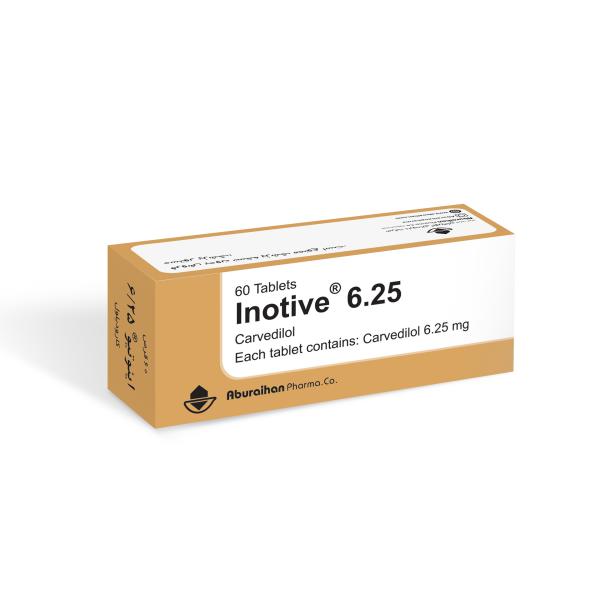Inotive ®
Carvedilol
6.25 – 12.5 – 25 mg film coated tablet
Heart failure with reduced ejection fraction: Treatment of mild to severe chronic heart failure of ischemic or cardiomyopathic origin or left ventricular dysfunction following myocardial infarction (clinically stable with left ventricular ejection fraction ≤40%).
Hypertension: Management of hypertension. Note: Beta-blockers are not recommended as first-line therapy
Use: Off-Label: Adult
Angina, chronic stable; Atrial fibrillation/flutter, maintenance of ventricular rate control; Myocardial infarction, early treatment and secondary prevention; Variceal hemorrhage prophylaxis
Mechanism of Action:
As a racemic mixture, carvedilol has nonselective beta-adrenoreceptor and alpha-adrenergic blocking activity. No intrinsic sympathomimetic activity has been documented. Associated effects in hypertensive patients include reduction of cardiac output, exercise- or beta-agonist-induced tachycardia, reduction of reflex orthostatic tachycardia, vasodilation, decreased peripheral vascular resistance (especially in standing position), decreased renal vascular resistance, reduced plasma renin activity, and increased levels of atrial natriuretic peptide.
Method of Administration:
Heart failure with reduced ejection fraction:
Immediate release: Oral: Initial: 3.125 mg twice daily; up-titrate gradually (eg, doubling the dose at 2-weeks, or longer, intervals) to the target dose while monitoring for signs and symptoms of heart failure
Target dose:
≤85 kg: 25 mg twice daily.
>85 kg: 50 mg twice daily.
Hypertension (alternative agent):
Immediate release: Oral: Initial: 6.25 mg twice daily; titrate in ≥1-week intervals as needed based on patient response; usual dosage range: 6.25 to 25 mg twice daily; maximum dose: 50 mg/day
Notes
Contraindications:
Serious hypersensitivity to carvedilol or any component of the formulation; decompensated cardiac failure requiring intravenous inotropic therapy; bronchial asthma or related bronchospastic conditions; second- or third-degree AV block, sick sinus syndrome, and severe bradycardia (except in patients with a functioning artificial pacemaker); cardiogenic shock; severe hepatic impairment.
Interactions:
CYP2C9 Inhibitors (Moderate): May increase the serum concentration of Carvedilol. Specifically, concentrations of the S-carvedilol enantiomer may be increased. Risk C: Monitor therapy
CYP2D6 Inhibitors (Moderate): May increase the serum concentration of Carvedilol. Risk C: Monitor therapy
CYP2D6 Inhibitors (Strong): May increase the serum concentration of Carvedilol. Risk C: Monitor therapy
Pregnancy and Lactation:
Exposure to beta-blockers during pregnancy may increase the risk for adverse events in the neonate. If maternal use of a beta-blocker is needed, fetal growth should be monitored during pregnancy and the newborn should be monitored for 48 hours after delivery for bradycardia, hypoglycemia, and respiratory depression.
It is not known if carvedilol is present in breast milk. The decision to continue or discontinue breastfeeding during therapy should consider the risk of infant exposure, the benefits of breastfeeding to the infant, and benefits of treatment to the mother. Use of a beta-blocker other than carvedilol may be preferred in a lactating female.
Warning and Precaution:
- Anaphylactic reactions: Use caution with history of severe anaphylaxis to allergens; patients taking beta-blockers may become more sensitive to repeated challenges. Treatment of anaphylaxis (eg, epinephrine) in patients taking beta-blockers may be ineffective or promote undesirable effects. • Bradycardia: May occur; reduce dosage if heart rate drops to
Adverse Reactions:
Cardiovascular: Hypotension (≤20%), orthostatic hypotension (≤20%)
Endocrine & metabolic: Hyperglycemia (5% to 12%), weight gain (10% to 12%)
Gastrointestinal: Diarrhea (1% to 12%)
Nervous system: Dizziness (2% to 32%), fatigue (24%)
Neuromuscular & skeletal: Asthenia (11%)
Storage:
Store below 30ºC and protect from light and moisture.



